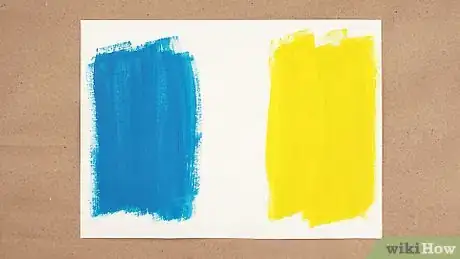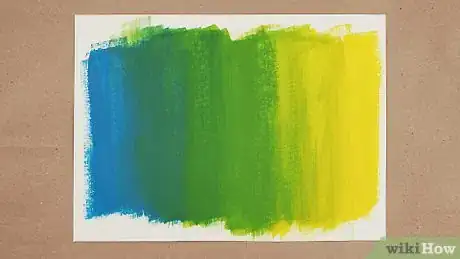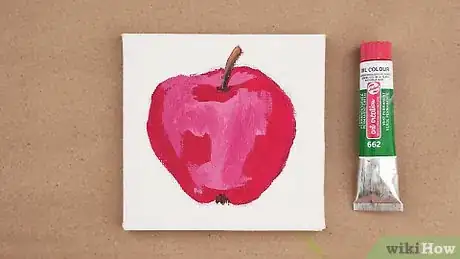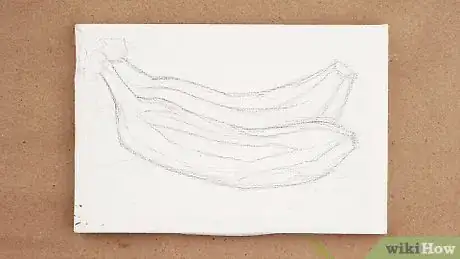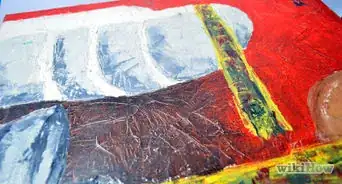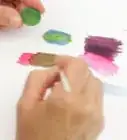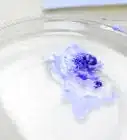This article was co-authored by Kelly Medford. Kelly Medford is an American painter based in Rome, Italy. She studied classical painting, drawing and printmaking both in the U.S. and in Italy. She works primarily en plein air on the streets of Rome, and also travels for private international collectors on commission. She founded Sketching Rome Tours in 2012 where she teaches sketchbook journaling to visitors of Rome. Kelly is a graduate of the Florence Academy of Art.
There are 9 references cited in this article, which can be found at the bottom of the page.
wikiHow marks an article as reader-approved once it receives enough positive feedback. In this case, several readers have written to tell us that this article was helpful to them, earning it our reader-approved status.
This article has been viewed 98,114 times.
Blending oil paints is different from blending other mediums because the paints take so long to dry. Because you have more time to adjust your blend, you can make a more even gradient between two colors. Once you've got a hand on blending two colors, you can shade (darken) or tint (lighten) your drawings, too. You don't have to be Monet or Van Gogh to blend oil paints beautifully!
Steps
Blending Two Colors
-
1Apply the two colors you want on opposite sides of each other. Use two separate brushes or clean your brushes between use to keep the two sides unmixed. Leave a gap in the middle of the two colors so you can create a smooth blend.[1]
- Try blending on a practice sheet before you work on your painting.
- How much paint you lay down depends on what texture you want to give the artwork. For a thicker texture, add more paint.
-
2Mix the colors on your palette. This will be a combination of the same colors you laid down beforehand. Make the mixture as even as possible. Add the same amount of each color, and use your paintbrush to combine the colors smoothly.[2]Advertisement
-
3Apply the mixed color between the two colors. Fill the blank space in the middle of the two colors entirely with the mixed color. Do not begin blending the colors quite yet. Wash out your paintbrush with paint thinner first so you can create a clean blend.
-
4Move your paint brush back and forth between the colors. Pretend you are drawing a "Z." Make your paintbrush go in a zig-zag pattern between the two unblended colors and your mixed color. Then, brush up and down between the colors. Watch the color carefully as it blends into the mixture in the middle.[3]
-
5Finish your painting as it dries. Unlike acrylics, you have time to blend your colors evenly. Add fresh paint on top of your colors if the paint dries early. This will make the paint wet and able to blend again. When you're satisfied with your blending job, set the painting somewhere safe to dry completely.
- Oil paint generally takes between 3-7 days to cure completely.[4]
Shading Your Art
-
1Apply the object's base color first as an undertone. Your first coat of paint should be light so you can add shade on top without adding the paint on too thickly. When you're satisfied with the object's base color, you are ready to start shading.
- If you're painting an apple, for example, apply red paint to your drawing as an undertone.
-
2Determine which direction the light is coming from. You will apply shade to the opposite side of the object facing the light source. The parts of your object closest to the light source will be brightest, while the parts furthest away will have the most shade. Pick a spot for your light source and paint accordingly.[5]
-
3Find your paint's complimentary color. Although you can use black to shade your painting, a darker shade of the object's complimentary color will provide a more natural shadowing. Consult a color wheel and mix a dark shade on your palette (to be applied on your object).[6]
- If your object is a red apple, for example, choose a dark shade of green.
-
4Add a dark shade of that color to your object based on the lighting. Paint on the darker color to the parts of your object further from the light source. Then, blend the shade into your object by moving between the dark and light color with your paintbrush (in a zig-zag pattern) until the edges between the two colors are soft.[7]
- To shade an apple, for example, add dark green paint on the parts of the apple furthest from the light source.
Tinting Oil Paints
-
1Determine your light source. Your object will be tinted where the light source directly hits the object. Choose a position for your light source and plan to tint the object accordingly. Mark your light source down so you don't forget as you paint and tint the wrong areas.
- Combine tinting and shading on your object for a more realistic sense of depth.
-
2Apply your base color. Much like shading, apply the base color to everywhere except the area you plan to tint. For that part, leave an unpainted patch to fill in later. You might sketch the object in strong lines beforehand so you can avoid painting over the potentially tinted area.
- Sketch the object in pencil, charcoal, or ink before you paint.
- If you are painting a banana, for example, add a yellow base color.
-
3Mix your base color with white on your palette. The intensity of your light source will determine how much white you add to your color. If your source is brilliant, like the sun, add a larger amount of white. If your source is dim, like a light bulb, add less.[8]
- For example: mix yellow and white if you are painting a banana.
-
4Paint your mixed color in the center of the empty space. Then, begin blending the base color and mixed paint by moving your paintbrush back and forth in a zig-zag pattern. Wait until your paint is evenly blended, then find a safe place for your canvas to dry.
- As an example, apply the white-yellow mix to the empty space on a banana painting.
Expert Q&A
-
QuestionHow do you blend oil pants?
 Kelly MedfordKelly Medford is an American painter based in Rome, Italy. She studied classical painting, drawing and printmaking both in the U.S. and in Italy. She works primarily en plein air on the streets of Rome, and also travels for private international collectors on commission. She founded Sketching Rome Tours in 2012 where she teaches sketchbook journaling to visitors of Rome. Kelly is a graduate of the Florence Academy of Art.
Kelly MedfordKelly Medford is an American painter based in Rome, Italy. She studied classical painting, drawing and printmaking both in the U.S. and in Italy. She works primarily en plein air on the streets of Rome, and also travels for private international collectors on commission. She founded Sketching Rome Tours in 2012 where she teaches sketchbook journaling to visitors of Rome. Kelly is a graduate of the Florence Academy of Art.
Professional Painter One way to blend colors is to put one color a brushstroke next to the other that is very close in value. Keep applying one stroke next to another with colors that are very close so that the edges between them are visually soft. You won’t have an abrupt change, but gradual changes.
One way to blend colors is to put one color a brushstroke next to the other that is very close in value. Keep applying one stroke next to another with colors that are very close so that the edges between them are visually soft. You won’t have an abrupt change, but gradual changes. -
QuestionWhat are the required items for oil painting?
 Community AnswerA canvas, flat synthetic brushes, oil paints (artist oil paints for better effect), turpentine oil, linseed oil.
Community AnswerA canvas, flat synthetic brushes, oil paints (artist oil paints for better effect), turpentine oil, linseed oil. -
QuestionWhat paints do I mix to create a flesh color?
 Community AnswerStart with white and slowly add dots of red and brown until you reach your desired color.
Community AnswerStart with white and slowly add dots of red and brown until you reach your desired color.
Warnings
- Oil paint fumes can be toxic (especially if it contains turpentine). Paint in a well-ventilated area, preferably near a window.[9]⧼thumbs_response⧽
References
- ↑ https://www.youtube.com/watch?v=cZQenv3xU4A&feature=youtu.be&t=95
- ↑ https://www.youtube.com/watch?v=cZQenv3xU4A&feature=youtu.be&t=106
- ↑ http://guidetooilpainting.com/blends.html
- ↑ http://salvagedinspirations.com/paint-dry-and-paint-cure/
- ↑ http://guidetooilpainting.com/shadows.html
- ↑ https://www.youtube.com/watch?v=MbafYVQWGgY&feature=youtu.be&t=79
- ↑ https://www.artistsandillustrators.co.uk/how-to/Floral-Nature/1492/how-to-paint-yellow-shadows
- ↑ http://guidetooilpainting.com/colorForm.html
- ↑ http://www.nytimes.com/health/guides/poison/turpentine-oil/overview.html
About This Article
To blend oil paint, start by using separate brushes to apply the 2 colors you want to combine to your palette, making sure to leave a gap between them. Then, use a clean brush to add the same amount of each color to a different spot on your palette, and mix them until you get a smooth, new color. Next, apply the new color to the gap between the 2 original colors, then clean your paintbrush with paint thinner. After that, move your brush in a zig-zag pattern across the 3 colors, then up and down to thoroughly blend your new color. For tips on how to tint oil paint to get the exact shade you want, keep reading!
